BSBHRM404: HR Metrics, Workforce Data Analysis, and Technology Review
VerifiedAdded on 2023/01/13
|5
|978
|50
Report
AI Summary
This report examines the human resource function, focusing on HR metrics and workforce data analysis for STAR Industries. It identifies eight types of workforce data, including family background, educational qualifications, medical information, past employment, investigation records, pay scale, past performance, and other achievements, along with their respective data sources. The report also explores technologies like AI, social media, ATS, and video interviewing to efficiently gather workforce data. The report provides a comprehensive review of HR practices and the use of technology in enhancing recruitment and overall organizational productivity. The report is based on the assignment brief which requires the student to gather and analyze workforce data on the population of Strathfield, using Census data from the Australian Bureau of Statistics (ABS) website.
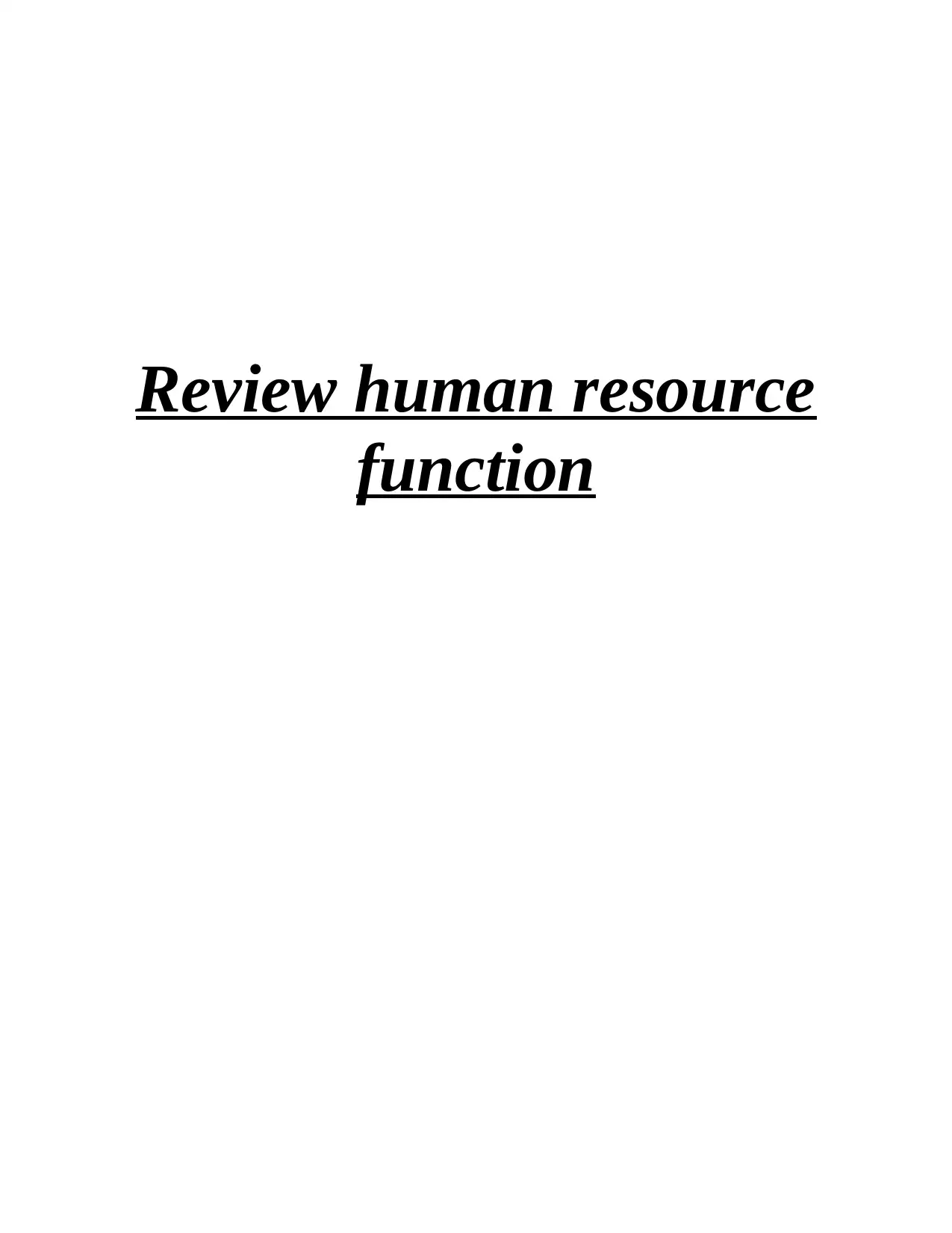
Review human resource
function
function
Paraphrase This Document
Need a fresh take? Get an instant paraphrase of this document with our AI Paraphraser
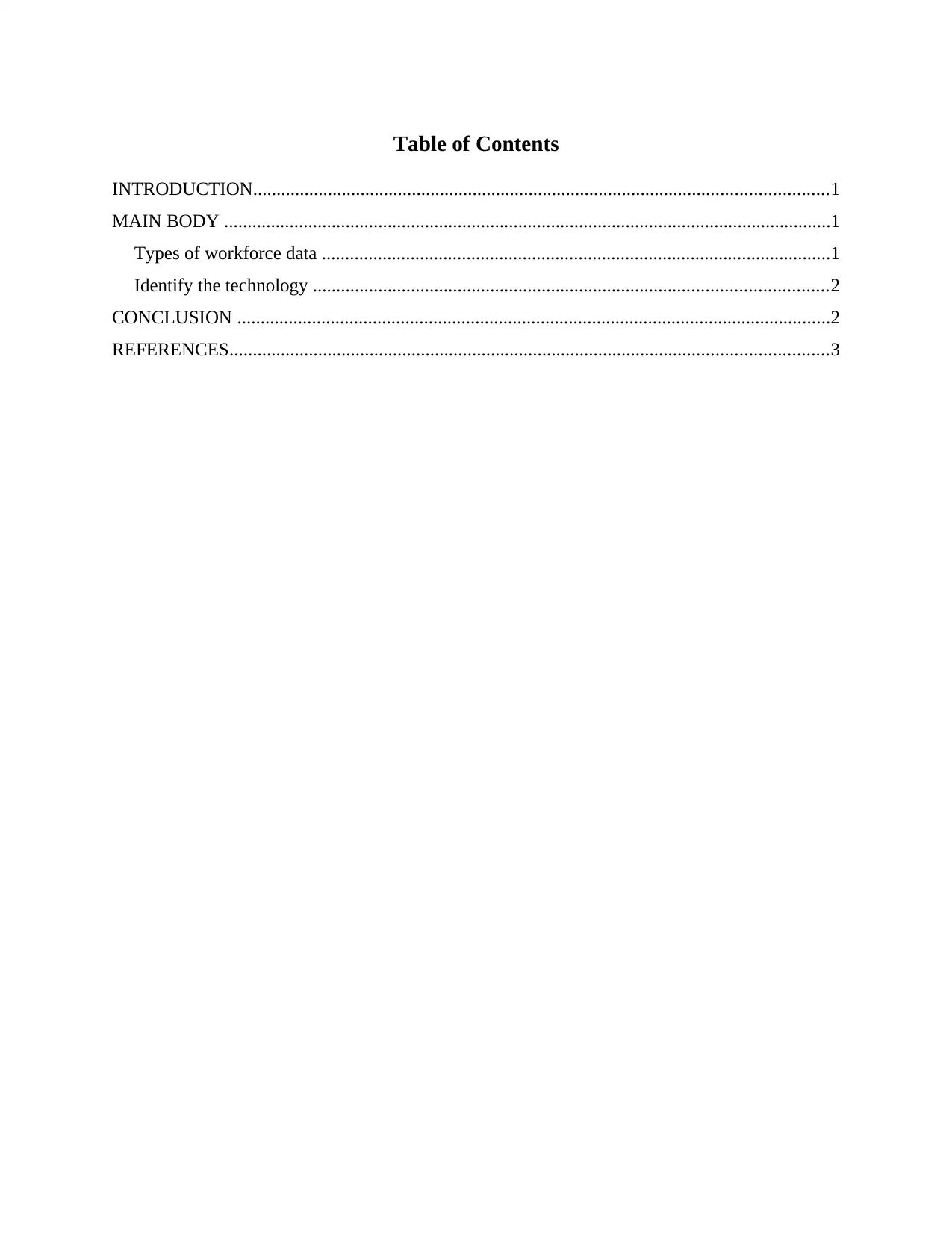
Table of Contents
INTRODUCTION...........................................................................................................................1
MAIN BODY ..................................................................................................................................1
Types of workforce data .............................................................................................................1
Identify the technology ..............................................................................................................2
CONCLUSION ...............................................................................................................................2
REFERENCES................................................................................................................................3
INTRODUCTION...........................................................................................................................1
MAIN BODY ..................................................................................................................................1
Types of workforce data .............................................................................................................1
Identify the technology ..............................................................................................................2
CONCLUSION ...............................................................................................................................2
REFERENCES................................................................................................................................3
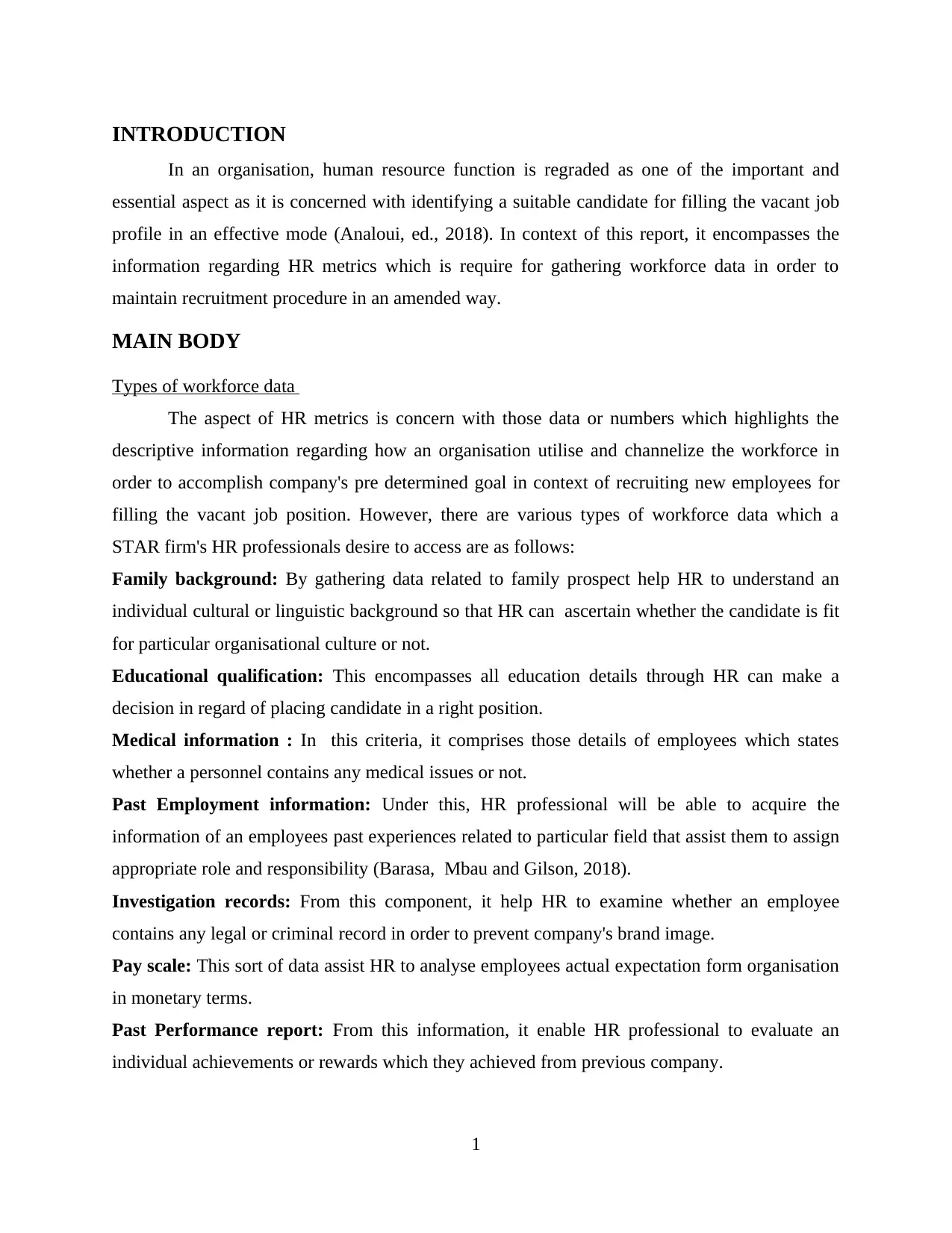
INTRODUCTION
In an organisation, human resource function is regraded as one of the important and
essential aspect as it is concerned with identifying a suitable candidate for filling the vacant job
profile in an effective mode (Analoui, ed., 2018). In context of this report, it encompasses the
information regarding HR metrics which is require for gathering workforce data in order to
maintain recruitment procedure in an amended way.
MAIN BODY
Types of workforce data
The aspect of HR metrics is concern with those data or numbers which highlights the
descriptive information regarding how an organisation utilise and channelize the workforce in
order to accomplish company's pre determined goal in context of recruiting new employees for
filling the vacant job position. However, there are various types of workforce data which a
STAR firm's HR professionals desire to access are as follows:
Family background: By gathering data related to family prospect help HR to understand an
individual cultural or linguistic background so that HR can ascertain whether the candidate is fit
for particular organisational culture or not.
Educational qualification: This encompasses all education details through HR can make a
decision in regard of placing candidate in a right position.
Medical information : In this criteria, it comprises those details of employees which states
whether a personnel contains any medical issues or not.
Past Employment information: Under this, HR professional will be able to acquire the
information of an employees past experiences related to particular field that assist them to assign
appropriate role and responsibility (Barasa, Mbau and Gilson, 2018).
Investigation records: From this component, it help HR to examine whether an employee
contains any legal or criminal record in order to prevent company's brand image.
Pay scale: This sort of data assist HR to analyse employees actual expectation form organisation
in monetary terms.
Past Performance report: From this information, it enable HR professional to evaluate an
individual achievements or rewards which they achieved from previous company.
1
In an organisation, human resource function is regraded as one of the important and
essential aspect as it is concerned with identifying a suitable candidate for filling the vacant job
profile in an effective mode (Analoui, ed., 2018). In context of this report, it encompasses the
information regarding HR metrics which is require for gathering workforce data in order to
maintain recruitment procedure in an amended way.
MAIN BODY
Types of workforce data
The aspect of HR metrics is concern with those data or numbers which highlights the
descriptive information regarding how an organisation utilise and channelize the workforce in
order to accomplish company's pre determined goal in context of recruiting new employees for
filling the vacant job position. However, there are various types of workforce data which a
STAR firm's HR professionals desire to access are as follows:
Family background: By gathering data related to family prospect help HR to understand an
individual cultural or linguistic background so that HR can ascertain whether the candidate is fit
for particular organisational culture or not.
Educational qualification: This encompasses all education details through HR can make a
decision in regard of placing candidate in a right position.
Medical information : In this criteria, it comprises those details of employees which states
whether a personnel contains any medical issues or not.
Past Employment information: Under this, HR professional will be able to acquire the
information of an employees past experiences related to particular field that assist them to assign
appropriate role and responsibility (Barasa, Mbau and Gilson, 2018).
Investigation records: From this component, it help HR to examine whether an employee
contains any legal or criminal record in order to prevent company's brand image.
Pay scale: This sort of data assist HR to analyse employees actual expectation form organisation
in monetary terms.
Past Performance report: From this information, it enable HR professional to evaluate an
individual achievements or rewards which they achieved from previous company.
1
⊘ This is a preview!⊘
Do you want full access?
Subscribe today to unlock all pages.

Trusted by 1+ million students worldwide
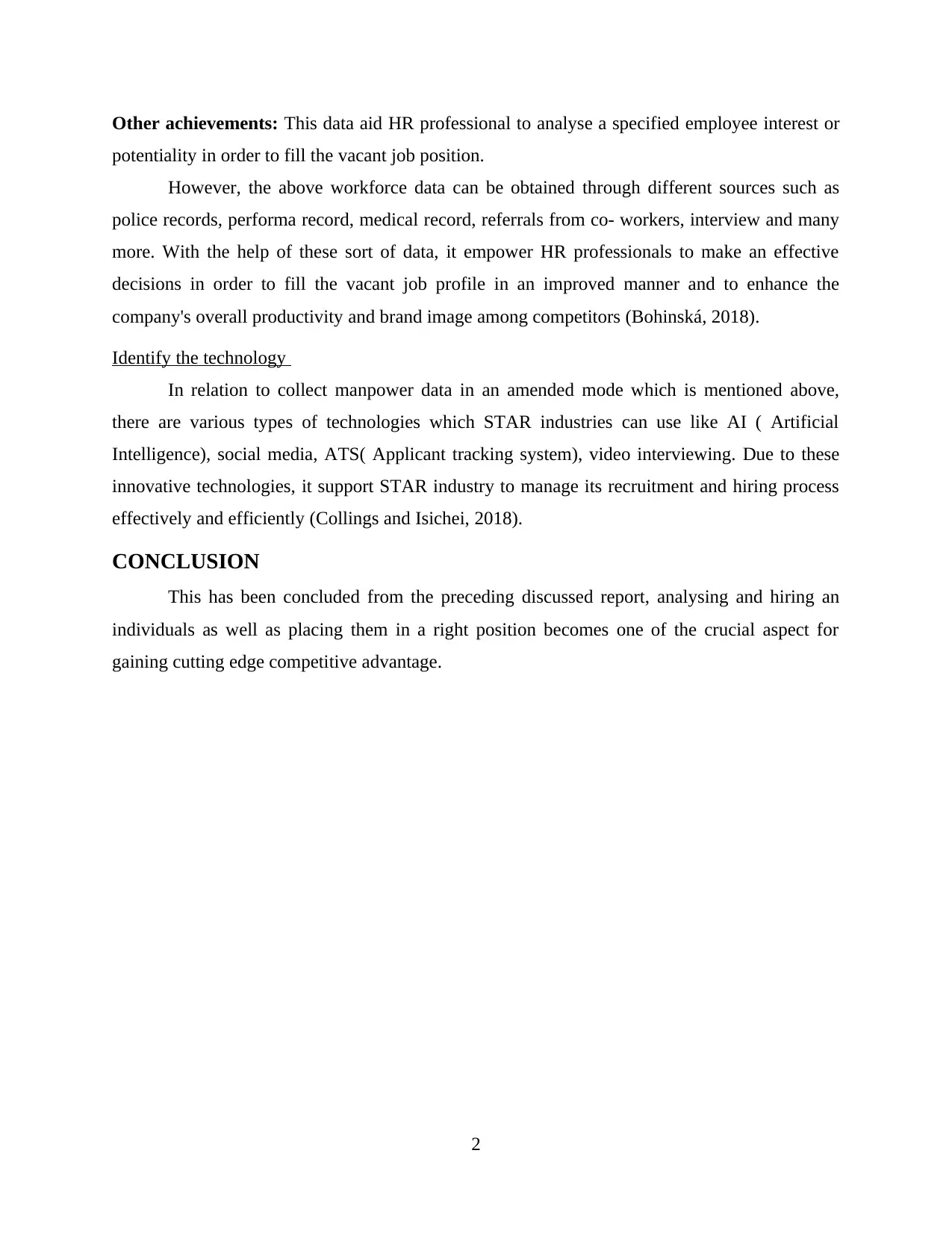
Other achievements: This data aid HR professional to analyse a specified employee interest or
potentiality in order to fill the vacant job position.
However, the above workforce data can be obtained through different sources such as
police records, performa record, medical record, referrals from co- workers, interview and many
more. With the help of these sort of data, it empower HR professionals to make an effective
decisions in order to fill the vacant job profile in an improved manner and to enhance the
company's overall productivity and brand image among competitors (Bohinská, 2018).
Identify the technology
In relation to collect manpower data in an amended mode which is mentioned above,
there are various types of technologies which STAR industries can use like AI ( Artificial
Intelligence), social media, ATS( Applicant tracking system), video interviewing. Due to these
innovative technologies, it support STAR industry to manage its recruitment and hiring process
effectively and efficiently (Collings and Isichei, 2018).
CONCLUSION
This has been concluded from the preceding discussed report, analysing and hiring an
individuals as well as placing them in a right position becomes one of the crucial aspect for
gaining cutting edge competitive advantage.
2
potentiality in order to fill the vacant job position.
However, the above workforce data can be obtained through different sources such as
police records, performa record, medical record, referrals from co- workers, interview and many
more. With the help of these sort of data, it empower HR professionals to make an effective
decisions in order to fill the vacant job profile in an improved manner and to enhance the
company's overall productivity and brand image among competitors (Bohinská, 2018).
Identify the technology
In relation to collect manpower data in an amended mode which is mentioned above,
there are various types of technologies which STAR industries can use like AI ( Artificial
Intelligence), social media, ATS( Applicant tracking system), video interviewing. Due to these
innovative technologies, it support STAR industry to manage its recruitment and hiring process
effectively and efficiently (Collings and Isichei, 2018).
CONCLUSION
This has been concluded from the preceding discussed report, analysing and hiring an
individuals as well as placing them in a right position becomes one of the crucial aspect for
gaining cutting edge competitive advantage.
2
Paraphrase This Document
Need a fresh take? Get an instant paraphrase of this document with our AI Paraphraser
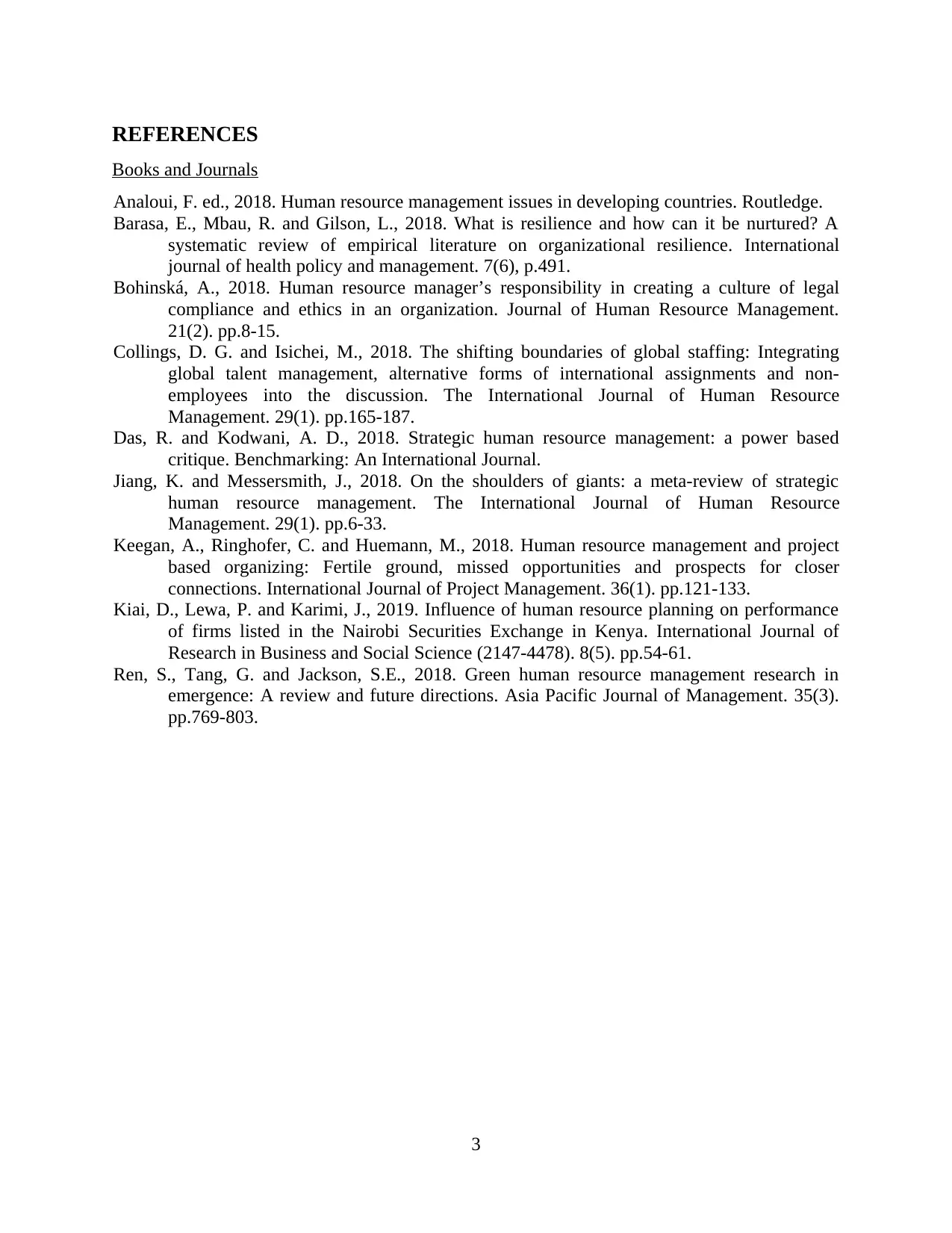
REFERENCES
Books and Journals
Analoui, F. ed., 2018. Human resource management issues in developing countries. Routledge.
Barasa, E., Mbau, R. and Gilson, L., 2018. What is resilience and how can it be nurtured? A
systematic review of empirical literature on organizational resilience. International
journal of health policy and management. 7(6), p.491.
Bohinská, A., 2018. Human resource manager’s responsibility in creating a culture of legal
compliance and ethics in an organization. Journal of Human Resource Management.
21(2). pp.8-15.
Collings, D. G. and Isichei, M., 2018. The shifting boundaries of global staffing: Integrating
global talent management, alternative forms of international assignments and non-
employees into the discussion. The International Journal of Human Resource
Management. 29(1). pp.165-187.
Das, R. and Kodwani, A. D., 2018. Strategic human resource management: a power based
critique. Benchmarking: An International Journal.
Jiang, K. and Messersmith, J., 2018. On the shoulders of giants: a meta-review of strategic
human resource management. The International Journal of Human Resource
Management. 29(1). pp.6-33.
Keegan, A., Ringhofer, C. and Huemann, M., 2018. Human resource management and project
based organizing: Fertile ground, missed opportunities and prospects for closer
connections. International Journal of Project Management. 36(1). pp.121-133.
Kiai, D., Lewa, P. and Karimi, J., 2019. Influence of human resource planning on performance
of firms listed in the Nairobi Securities Exchange in Kenya. International Journal of
Research in Business and Social Science (2147-4478). 8(5). pp.54-61.
Ren, S., Tang, G. and Jackson, S.E., 2018. Green human resource management research in
emergence: A review and future directions. Asia Pacific Journal of Management. 35(3).
pp.769-803.
3
Books and Journals
Analoui, F. ed., 2018. Human resource management issues in developing countries. Routledge.
Barasa, E., Mbau, R. and Gilson, L., 2018. What is resilience and how can it be nurtured? A
systematic review of empirical literature on organizational resilience. International
journal of health policy and management. 7(6), p.491.
Bohinská, A., 2018. Human resource manager’s responsibility in creating a culture of legal
compliance and ethics in an organization. Journal of Human Resource Management.
21(2). pp.8-15.
Collings, D. G. and Isichei, M., 2018. The shifting boundaries of global staffing: Integrating
global talent management, alternative forms of international assignments and non-
employees into the discussion. The International Journal of Human Resource
Management. 29(1). pp.165-187.
Das, R. and Kodwani, A. D., 2018. Strategic human resource management: a power based
critique. Benchmarking: An International Journal.
Jiang, K. and Messersmith, J., 2018. On the shoulders of giants: a meta-review of strategic
human resource management. The International Journal of Human Resource
Management. 29(1). pp.6-33.
Keegan, A., Ringhofer, C. and Huemann, M., 2018. Human resource management and project
based organizing: Fertile ground, missed opportunities and prospects for closer
connections. International Journal of Project Management. 36(1). pp.121-133.
Kiai, D., Lewa, P. and Karimi, J., 2019. Influence of human resource planning on performance
of firms listed in the Nairobi Securities Exchange in Kenya. International Journal of
Research in Business and Social Science (2147-4478). 8(5). pp.54-61.
Ren, S., Tang, G. and Jackson, S.E., 2018. Green human resource management research in
emergence: A review and future directions. Asia Pacific Journal of Management. 35(3).
pp.769-803.
3
1 out of 5
Related Documents
Your All-in-One AI-Powered Toolkit for Academic Success.
+13062052269
info@desklib.com
Available 24*7 on WhatsApp / Email
![[object Object]](/_next/static/media/star-bottom.7253800d.svg)
Unlock your academic potential
Copyright © 2020–2025 A2Z Services. All Rights Reserved. Developed and managed by ZUCOL.





